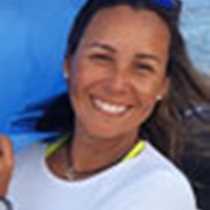Located in the southeastern end of the Galápagos archipelago, Española is one of the most interesting islands due to its landscape and wildlife. We woke up to a drizzly morning, typical of this time of the year, but despite this we could see how beautiful this area was. We were anchored at Gardner Bay, with its turquoise waters and white sandy beach. We started off by snorkeling at nearby Gardner Islet, in order to explore the underwater world. There were fantastic schools of razor surgeonfish, and other species like the parrot fish and king angel fish were also sighted. The weather soon improved and we landed at the beach, which is inhabited by some Galápagos sea lions. A dominant bull sea lion kept patrolling the length of the beach, at the same time trying to impress a few female sea lions in the vicinity. One of the most popular birds on this island is the endemic Española mockingbird. We saw several of them constantly looking for insects and plant material to eat on the sand. Many of our guests were able to relax and take a stroll on the beach, enjoying the warm air temperature, while others could explore the nearby coastline by kayak, one of the most popular activities of the week.
In the afternoon, we navigated further west along the coast of Española towards Punta Suárez, one of the most striking visitors’ sites of the Enchanted Islands. Upon arrival, we could observe various species endemic to this island, particularly the marine iguana, which shows a distinct coloration of turquoise and reddish scales besides the black ones during the breeding season. We were amazed by the number of iguanas in aggregations, basking in the warm afternoon sunshine. The trail continued through marine seabird colonies, mainly the Nazca boobies. They would rather inhabit the edge of the cliffs, therefore they had painted the lava rocks with a lot of guano! We were fortunate to spot a small colony of blue-footed boobies, one of the most emblematic species of the Galápagos in the middle of their breeding season, and one of the eggs had already hatched with a newborn chick being looked after by its father. The trail lead us to some magnificent cliffs from which we could see various sea birds pretty active in the late afternoon, like the swallow-tailed gulls, Galápagos shearwaters and frigates. The most famous inhabitant of Española is the waved albatross, a species that resides only on this island. Many individuals flew over our heads with their majestic wingspan of over 8 feet. We walked through their “airport,” and we saw some of the adults having a rest not far from various comical-looking albatross chicks. All of these unique creatures are part of this fantastic world of the Enchanted Islands, one that we seek and hope to maintain for the future. As the sun set upon our return back on board the National Geographic Endeavour, we certainly felt very fortunate to be able to witness the magic of one of the last natural laboratories of evolution on Earth.







